Graceland Day Care: Health and Safety Policy and Compliance Report
VerifiedAdded on 2020/01/16
|8
|2670
|194
Report
AI Summary
This report examines health and safety policies within the context of a health and social care setting, specifically focusing on Graceland day care center. The report delves into the impact of health and safety policies on care practices, emphasizing the importance of a positive health and safety culture. It analyzes the effectiveness of hand hygiene policies in preventing infections and promoting a safe environment for both patients and staff. Furthermore, the report explores the consequences of non-compliance with health and safety legislation, including potential risks to patient health and the implications for the care center. The report also discusses methods for monitoring and reviewing health and safety policies, such as hand hygiene audits and updating procedures, to ensure ongoing effectiveness and adherence to regulations. Overall, the report highlights the critical role of health and safety in delivering quality care and maintaining a safe workplace within the health and social care sector.
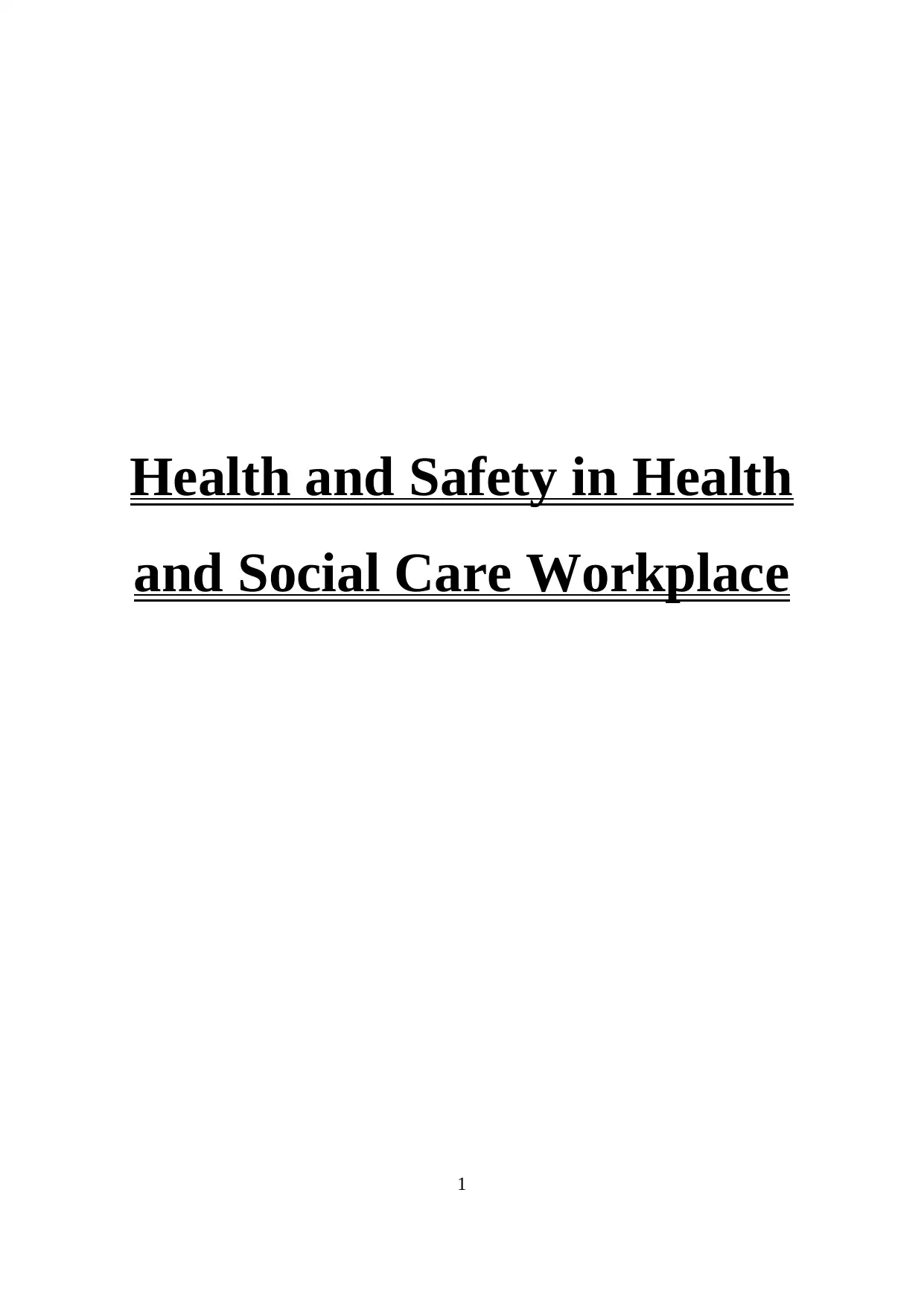
Health and Safety in Health
and Social Care Workplace
1
and Social Care Workplace
1
Paraphrase This Document
Need a fresh take? Get an instant paraphrase of this document with our AI Paraphraser
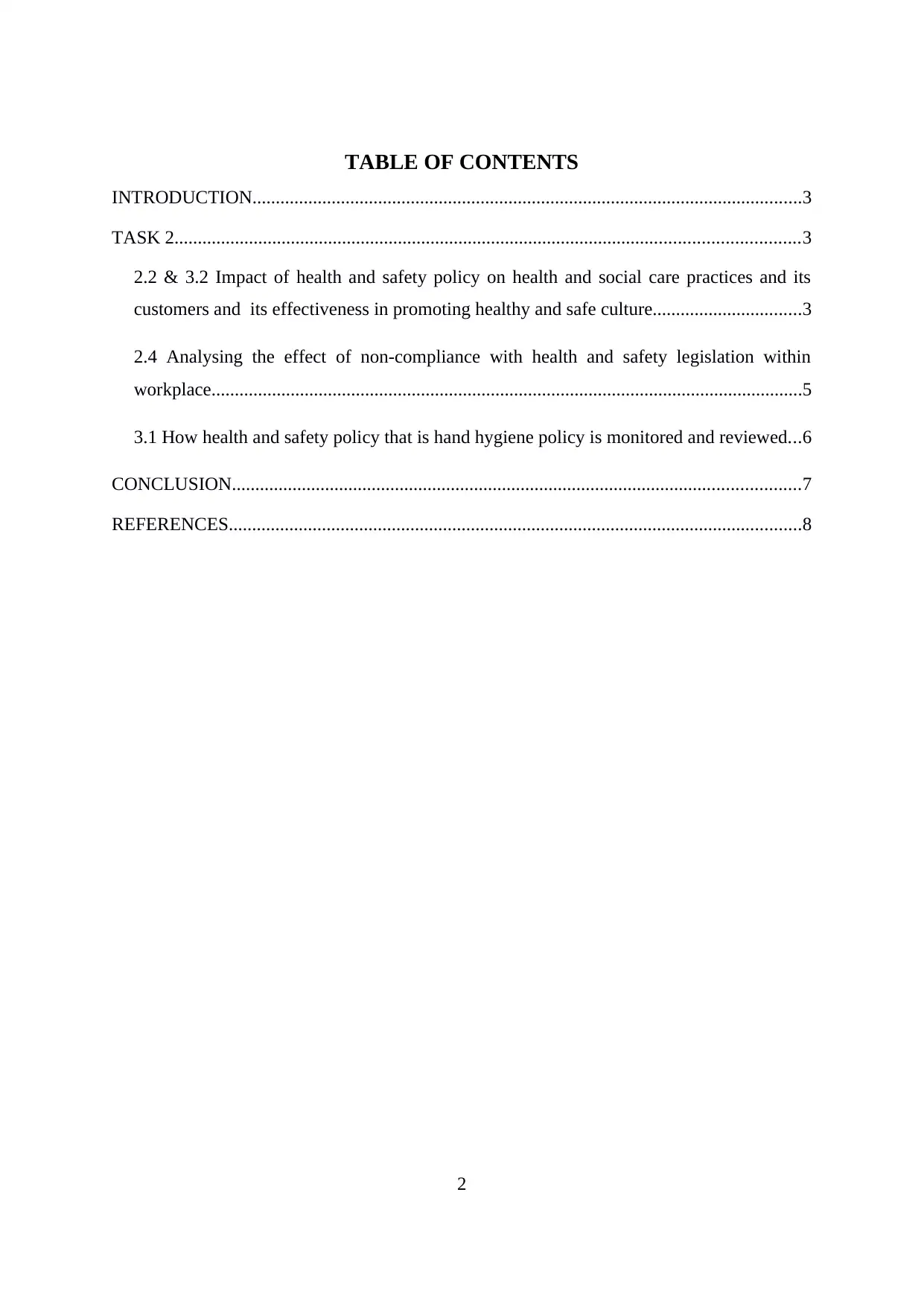
TABLE OF CONTENTS
INTRODUCTION......................................................................................................................3
TASK 2......................................................................................................................................3
2.2 & 3.2 Impact of health and safety policy on health and social care practices and its
customers and its effectiveness in promoting healthy and safe culture................................3
2.4 Analysing the effect of non-compliance with health and safety legislation within
workplace...............................................................................................................................5
3.1 How health and safety policy that is hand hygiene policy is monitored and reviewed...6
CONCLUSION..........................................................................................................................7
REFERENCES...........................................................................................................................8
2
INTRODUCTION......................................................................................................................3
TASK 2......................................................................................................................................3
2.2 & 3.2 Impact of health and safety policy on health and social care practices and its
customers and its effectiveness in promoting healthy and safe culture................................3
2.4 Analysing the effect of non-compliance with health and safety legislation within
workplace...............................................................................................................................5
3.1 How health and safety policy that is hand hygiene policy is monitored and reviewed...6
CONCLUSION..........................................................................................................................7
REFERENCES...........................................................................................................................8
2
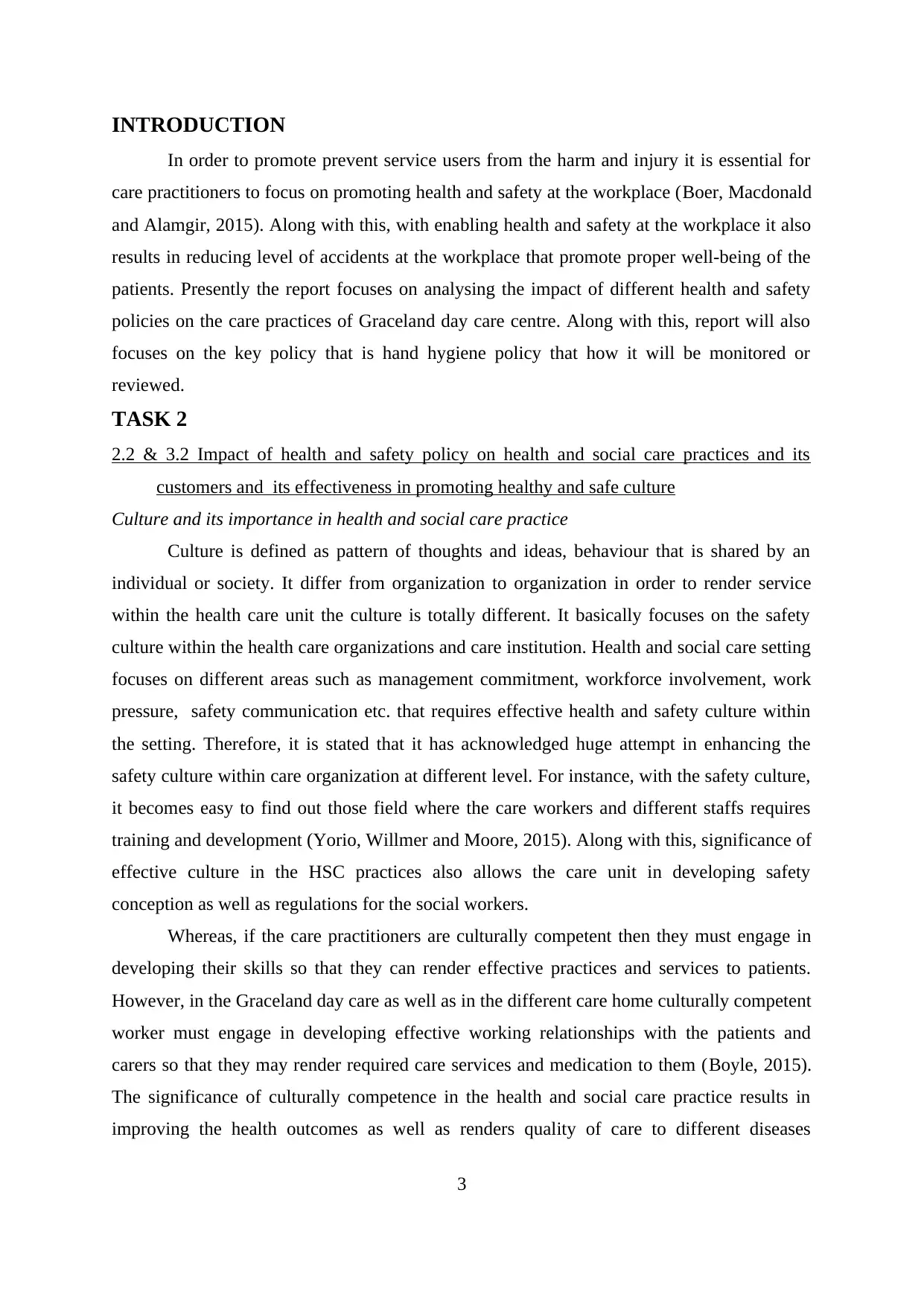
INTRODUCTION
In order to promote prevent service users from the harm and injury it is essential for
care practitioners to focus on promoting health and safety at the workplace (Boer, Macdonald
and Alamgir, 2015). Along with this, with enabling health and safety at the workplace it also
results in reducing level of accidents at the workplace that promote proper well-being of the
patients. Presently the report focuses on analysing the impact of different health and safety
policies on the care practices of Graceland day care centre. Along with this, report will also
focuses on the key policy that is hand hygiene policy that how it will be monitored or
reviewed.
TASK 2
2.2 & 3.2 Impact of health and safety policy on health and social care practices and its
customers and its effectiveness in promoting healthy and safe culture
Culture and its importance in health and social care practice
Culture is defined as pattern of thoughts and ideas, behaviour that is shared by an
individual or society. It differ from organization to organization in order to render service
within the health care unit the culture is totally different. It basically focuses on the safety
culture within the health care organizations and care institution. Health and social care setting
focuses on different areas such as management commitment, workforce involvement, work
pressure, safety communication etc. that requires effective health and safety culture within
the setting. Therefore, it is stated that it has acknowledged huge attempt in enhancing the
safety culture within care organization at different level. For instance, with the safety culture,
it becomes easy to find out those field where the care workers and different staffs requires
training and development (Yorio, Willmer and Moore, 2015). Along with this, significance of
effective culture in the HSC practices also allows the care unit in developing safety
conception as well as regulations for the social workers.
Whereas, if the care practitioners are culturally competent then they must engage in
developing their skills so that they can render effective practices and services to patients.
However, in the Graceland day care as well as in the different care home culturally competent
worker must engage in developing effective working relationships with the patients and
carers so that they may render required care services and medication to them (Boyle, 2015).
The significance of culturally competence in the health and social care practice results in
improving the health outcomes as well as renders quality of care to different diseases
3
In order to promote prevent service users from the harm and injury it is essential for
care practitioners to focus on promoting health and safety at the workplace (Boer, Macdonald
and Alamgir, 2015). Along with this, with enabling health and safety at the workplace it also
results in reducing level of accidents at the workplace that promote proper well-being of the
patients. Presently the report focuses on analysing the impact of different health and safety
policies on the care practices of Graceland day care centre. Along with this, report will also
focuses on the key policy that is hand hygiene policy that how it will be monitored or
reviewed.
TASK 2
2.2 & 3.2 Impact of health and safety policy on health and social care practices and its
customers and its effectiveness in promoting healthy and safe culture
Culture and its importance in health and social care practice
Culture is defined as pattern of thoughts and ideas, behaviour that is shared by an
individual or society. It differ from organization to organization in order to render service
within the health care unit the culture is totally different. It basically focuses on the safety
culture within the health care organizations and care institution. Health and social care setting
focuses on different areas such as management commitment, workforce involvement, work
pressure, safety communication etc. that requires effective health and safety culture within
the setting. Therefore, it is stated that it has acknowledged huge attempt in enhancing the
safety culture within care organization at different level. For instance, with the safety culture,
it becomes easy to find out those field where the care workers and different staffs requires
training and development (Yorio, Willmer and Moore, 2015). Along with this, significance of
effective culture in the HSC practices also allows the care unit in developing safety
conception as well as regulations for the social workers.
Whereas, if the care practitioners are culturally competent then they must engage in
developing their skills so that they can render effective practices and services to patients.
However, in the Graceland day care as well as in the different care home culturally competent
worker must engage in developing effective working relationships with the patients and
carers so that they may render required care services and medication to them (Boyle, 2015).
The significance of culturally competence in the health and social care practice results in
improving the health outcomes as well as renders quality of care to different diseases
3
⊘ This is a preview!⊘
Do you want full access?
Subscribe today to unlock all pages.

Trusted by 1+ million students worldwide
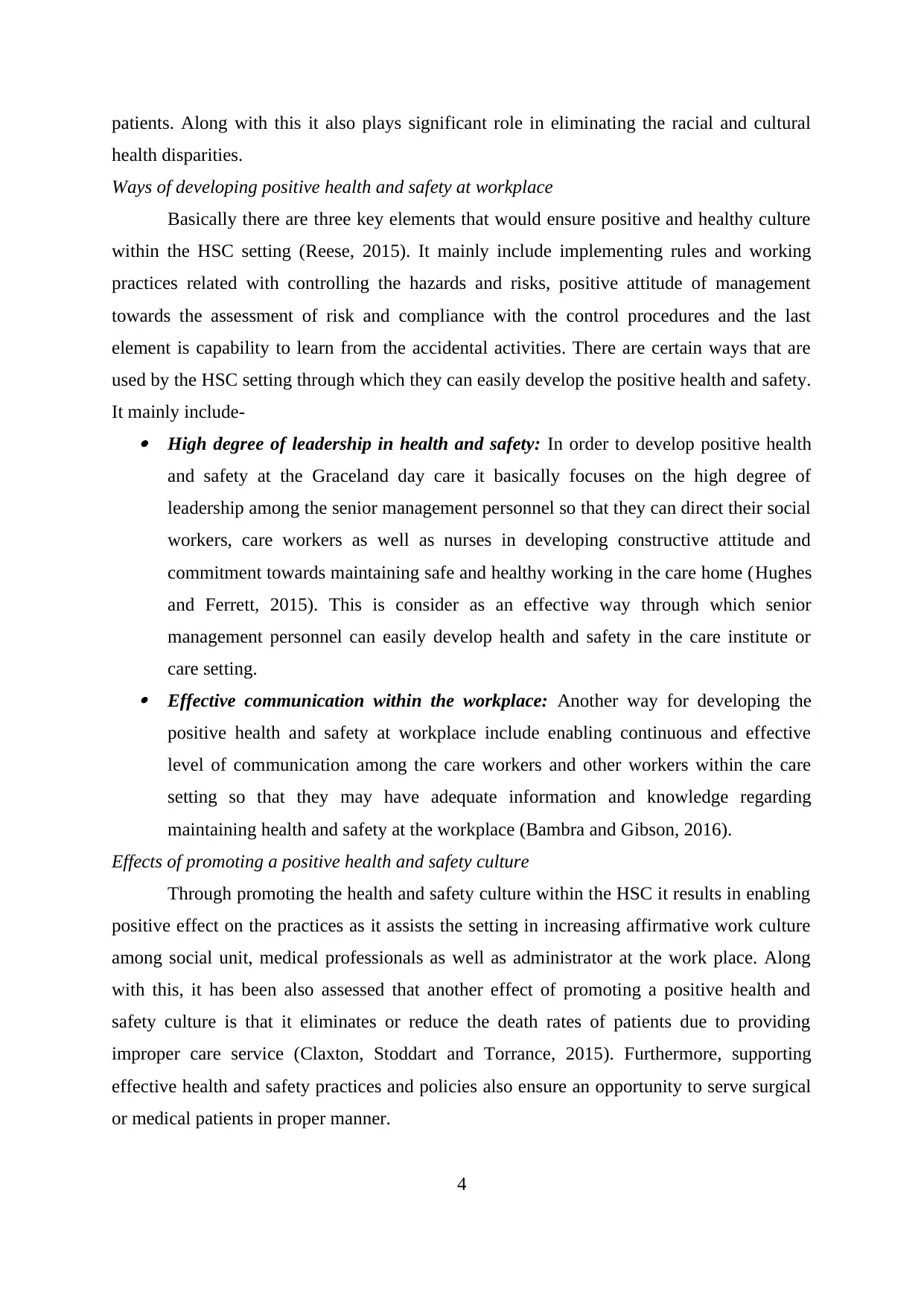
patients. Along with this it also plays significant role in eliminating the racial and cultural
health disparities.
Ways of developing positive health and safety at workplace
Basically there are three key elements that would ensure positive and healthy culture
within the HSC setting (Reese, 2015). It mainly include implementing rules and working
practices related with controlling the hazards and risks, positive attitude of management
towards the assessment of risk and compliance with the control procedures and the last
element is capability to learn from the accidental activities. There are certain ways that are
used by the HSC setting through which they can easily develop the positive health and safety.
It mainly include- High degree of leadership in health and safety: In order to develop positive health
and safety at the Graceland day care it basically focuses on the high degree of
leadership among the senior management personnel so that they can direct their social
workers, care workers as well as nurses in developing constructive attitude and
commitment towards maintaining safe and healthy working in the care home (Hughes
and Ferrett, 2015). This is consider as an effective way through which senior
management personnel can easily develop health and safety in the care institute or
care setting. Effective communication within the workplace: Another way for developing the
positive health and safety at workplace include enabling continuous and effective
level of communication among the care workers and other workers within the care
setting so that they may have adequate information and knowledge regarding
maintaining health and safety at the workplace (Bambra and Gibson, 2016).
Effects of promoting a positive health and safety culture
Through promoting the health and safety culture within the HSC it results in enabling
positive effect on the practices as it assists the setting in increasing affirmative work culture
among social unit, medical professionals as well as administrator at the work place. Along
with this, it has been also assessed that another effect of promoting a positive health and
safety culture is that it eliminates or reduce the death rates of patients due to providing
improper care service (Claxton, Stoddart and Torrance, 2015). Furthermore, supporting
effective health and safety practices and policies also ensure an opportunity to serve surgical
or medical patients in proper manner.
4
health disparities.
Ways of developing positive health and safety at workplace
Basically there are three key elements that would ensure positive and healthy culture
within the HSC setting (Reese, 2015). It mainly include implementing rules and working
practices related with controlling the hazards and risks, positive attitude of management
towards the assessment of risk and compliance with the control procedures and the last
element is capability to learn from the accidental activities. There are certain ways that are
used by the HSC setting through which they can easily develop the positive health and safety.
It mainly include- High degree of leadership in health and safety: In order to develop positive health
and safety at the Graceland day care it basically focuses on the high degree of
leadership among the senior management personnel so that they can direct their social
workers, care workers as well as nurses in developing constructive attitude and
commitment towards maintaining safe and healthy working in the care home (Hughes
and Ferrett, 2015). This is consider as an effective way through which senior
management personnel can easily develop health and safety in the care institute or
care setting. Effective communication within the workplace: Another way for developing the
positive health and safety at workplace include enabling continuous and effective
level of communication among the care workers and other workers within the care
setting so that they may have adequate information and knowledge regarding
maintaining health and safety at the workplace (Bambra and Gibson, 2016).
Effects of promoting a positive health and safety culture
Through promoting the health and safety culture within the HSC it results in enabling
positive effect on the practices as it assists the setting in increasing affirmative work culture
among social unit, medical professionals as well as administrator at the work place. Along
with this, it has been also assessed that another effect of promoting a positive health and
safety culture is that it eliminates or reduce the death rates of patients due to providing
improper care service (Claxton, Stoddart and Torrance, 2015). Furthermore, supporting
effective health and safety practices and policies also ensure an opportunity to serve surgical
or medical patients in proper manner.
4
Paraphrase This Document
Need a fresh take? Get an instant paraphrase of this document with our AI Paraphraser
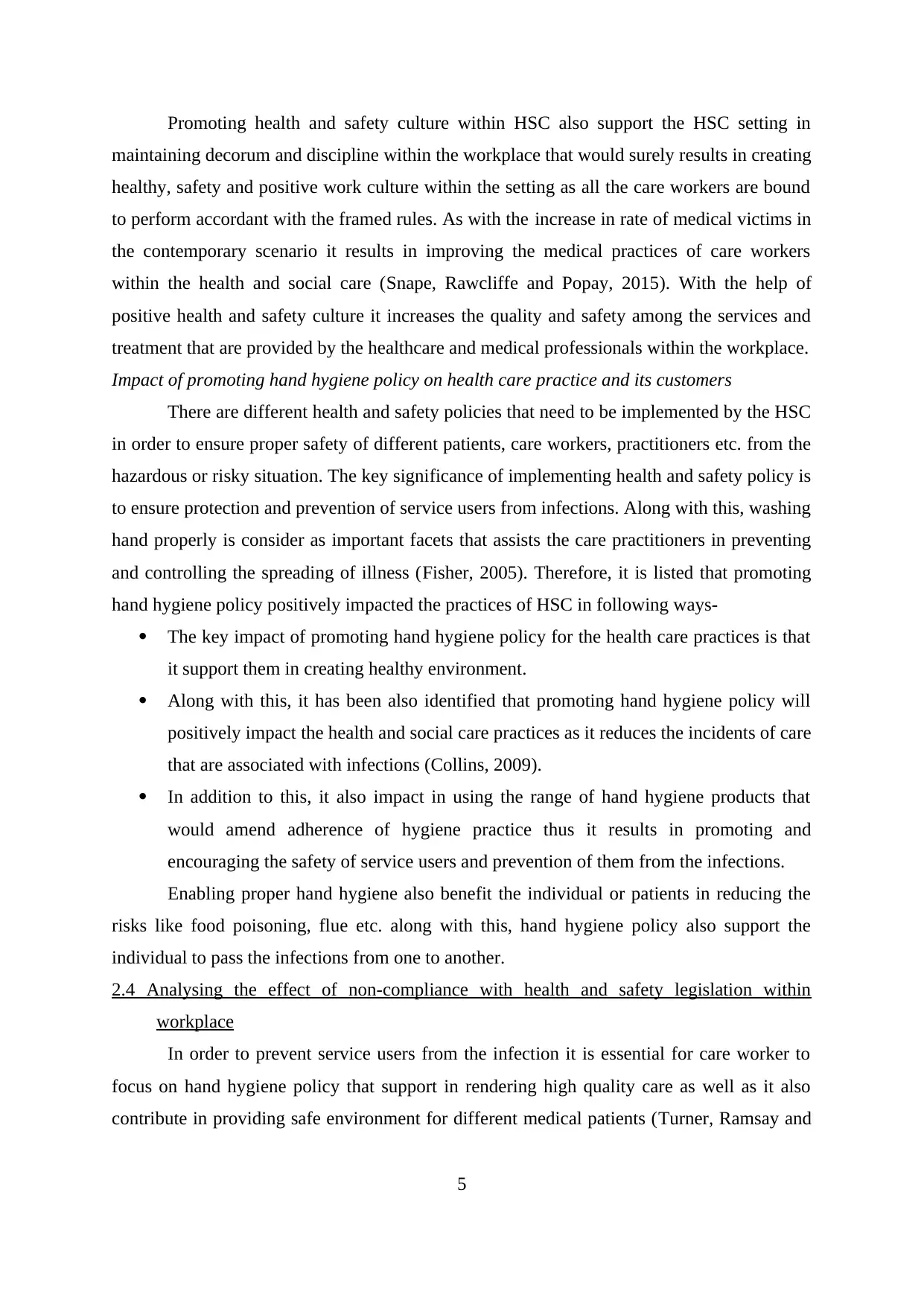
Promoting health and safety culture within HSC also support the HSC setting in
maintaining decorum and discipline within the workplace that would surely results in creating
healthy, safety and positive work culture within the setting as all the care workers are bound
to perform accordant with the framed rules. As with the increase in rate of medical victims in
the contemporary scenario it results in improving the medical practices of care workers
within the health and social care (Snape, Rawcliffe and Popay, 2015). With the help of
positive health and safety culture it increases the quality and safety among the services and
treatment that are provided by the healthcare and medical professionals within the workplace.
Impact of promoting hand hygiene policy on health care practice and its customers
There are different health and safety policies that need to be implemented by the HSC
in order to ensure proper safety of different patients, care workers, practitioners etc. from the
hazardous or risky situation. The key significance of implementing health and safety policy is
to ensure protection and prevention of service users from infections. Along with this, washing
hand properly is consider as important facets that assists the care practitioners in preventing
and controlling the spreading of illness (Fisher, 2005). Therefore, it is listed that promoting
hand hygiene policy positively impacted the practices of HSC in following ways-
The key impact of promoting hand hygiene policy for the health care practices is that
it support them in creating healthy environment.
Along with this, it has been also identified that promoting hand hygiene policy will
positively impact the health and social care practices as it reduces the incidents of care
that are associated with infections (Collins, 2009).
In addition to this, it also impact in using the range of hand hygiene products that
would amend adherence of hygiene practice thus it results in promoting and
encouraging the safety of service users and prevention of them from the infections.
Enabling proper hand hygiene also benefit the individual or patients in reducing the
risks like food poisoning, flue etc. along with this, hand hygiene policy also support the
individual to pass the infections from one to another.
2.4 Analysing the effect of non-compliance with health and safety legislation within
workplace
In order to prevent service users from the infection it is essential for care worker to
focus on hand hygiene policy that support in rendering high quality care as well as it also
contribute in providing safe environment for different medical patients (Turner, Ramsay and
5
maintaining decorum and discipline within the workplace that would surely results in creating
healthy, safety and positive work culture within the setting as all the care workers are bound
to perform accordant with the framed rules. As with the increase in rate of medical victims in
the contemporary scenario it results in improving the medical practices of care workers
within the health and social care (Snape, Rawcliffe and Popay, 2015). With the help of
positive health and safety culture it increases the quality and safety among the services and
treatment that are provided by the healthcare and medical professionals within the workplace.
Impact of promoting hand hygiene policy on health care practice and its customers
There are different health and safety policies that need to be implemented by the HSC
in order to ensure proper safety of different patients, care workers, practitioners etc. from the
hazardous or risky situation. The key significance of implementing health and safety policy is
to ensure protection and prevention of service users from infections. Along with this, washing
hand properly is consider as important facets that assists the care practitioners in preventing
and controlling the spreading of illness (Fisher, 2005). Therefore, it is listed that promoting
hand hygiene policy positively impacted the practices of HSC in following ways-
The key impact of promoting hand hygiene policy for the health care practices is that
it support them in creating healthy environment.
Along with this, it has been also identified that promoting hand hygiene policy will
positively impact the health and social care practices as it reduces the incidents of care
that are associated with infections (Collins, 2009).
In addition to this, it also impact in using the range of hand hygiene products that
would amend adherence of hygiene practice thus it results in promoting and
encouraging the safety of service users and prevention of them from the infections.
Enabling proper hand hygiene also benefit the individual or patients in reducing the
risks like food poisoning, flue etc. along with this, hand hygiene policy also support the
individual to pass the infections from one to another.
2.4 Analysing the effect of non-compliance with health and safety legislation within
workplace
In order to prevent service users from the infection it is essential for care worker to
focus on hand hygiene policy that support in rendering high quality care as well as it also
contribute in providing safe environment for different medical patients (Turner, Ramsay and
5
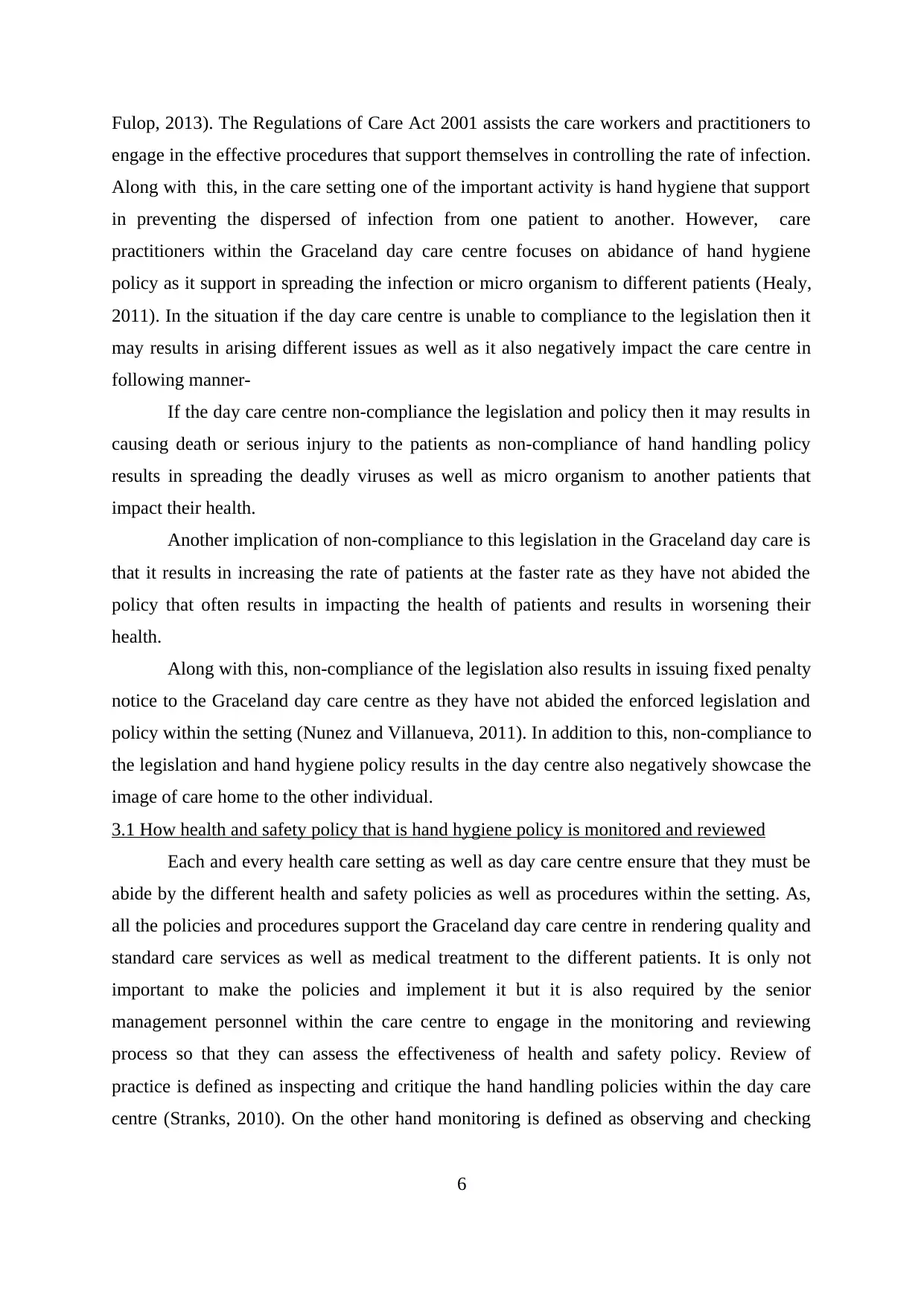
Fulop, 2013). The Regulations of Care Act 2001 assists the care workers and practitioners to
engage in the effective procedures that support themselves in controlling the rate of infection.
Along with this, in the care setting one of the important activity is hand hygiene that support
in preventing the dispersed of infection from one patient to another. However, care
practitioners within the Graceland day care centre focuses on abidance of hand hygiene
policy as it support in spreading the infection or micro organism to different patients (Healy,
2011). In the situation if the day care centre is unable to compliance to the legislation then it
may results in arising different issues as well as it also negatively impact the care centre in
following manner-
If the day care centre non-compliance the legislation and policy then it may results in
causing death or serious injury to the patients as non-compliance of hand handling policy
results in spreading the deadly viruses as well as micro organism to another patients that
impact their health.
Another implication of non-compliance to this legislation in the Graceland day care is
that it results in increasing the rate of patients at the faster rate as they have not abided the
policy that often results in impacting the health of patients and results in worsening their
health.
Along with this, non-compliance of the legislation also results in issuing fixed penalty
notice to the Graceland day care centre as they have not abided the enforced legislation and
policy within the setting (Nunez and Villanueva, 2011). In addition to this, non-compliance to
the legislation and hand hygiene policy results in the day centre also negatively showcase the
image of care home to the other individual.
3.1 How health and safety policy that is hand hygiene policy is monitored and reviewed
Each and every health care setting as well as day care centre ensure that they must be
abide by the different health and safety policies as well as procedures within the setting. As,
all the policies and procedures support the Graceland day care centre in rendering quality and
standard care services as well as medical treatment to the different patients. It is only not
important to make the policies and implement it but it is also required by the senior
management personnel within the care centre to engage in the monitoring and reviewing
process so that they can assess the effectiveness of health and safety policy. Review of
practice is defined as inspecting and critique the hand handling policies within the day care
centre (Stranks, 2010). On the other hand monitoring is defined as observing and checking
6
engage in the effective procedures that support themselves in controlling the rate of infection.
Along with this, in the care setting one of the important activity is hand hygiene that support
in preventing the dispersed of infection from one patient to another. However, care
practitioners within the Graceland day care centre focuses on abidance of hand hygiene
policy as it support in spreading the infection or micro organism to different patients (Healy,
2011). In the situation if the day care centre is unable to compliance to the legislation then it
may results in arising different issues as well as it also negatively impact the care centre in
following manner-
If the day care centre non-compliance the legislation and policy then it may results in
causing death or serious injury to the patients as non-compliance of hand handling policy
results in spreading the deadly viruses as well as micro organism to another patients that
impact their health.
Another implication of non-compliance to this legislation in the Graceland day care is
that it results in increasing the rate of patients at the faster rate as they have not abided the
policy that often results in impacting the health of patients and results in worsening their
health.
Along with this, non-compliance of the legislation also results in issuing fixed penalty
notice to the Graceland day care centre as they have not abided the enforced legislation and
policy within the setting (Nunez and Villanueva, 2011). In addition to this, non-compliance to
the legislation and hand hygiene policy results in the day centre also negatively showcase the
image of care home to the other individual.
3.1 How health and safety policy that is hand hygiene policy is monitored and reviewed
Each and every health care setting as well as day care centre ensure that they must be
abide by the different health and safety policies as well as procedures within the setting. As,
all the policies and procedures support the Graceland day care centre in rendering quality and
standard care services as well as medical treatment to the different patients. It is only not
important to make the policies and implement it but it is also required by the senior
management personnel within the care centre to engage in the monitoring and reviewing
process so that they can assess the effectiveness of health and safety policy. Review of
practice is defined as inspecting and critique the hand handling policies within the day care
centre (Stranks, 2010). On the other hand monitoring is defined as observing and checking
6
⊘ This is a preview!⊘
Do you want full access?
Subscribe today to unlock all pages.

Trusted by 1+ million students worldwide
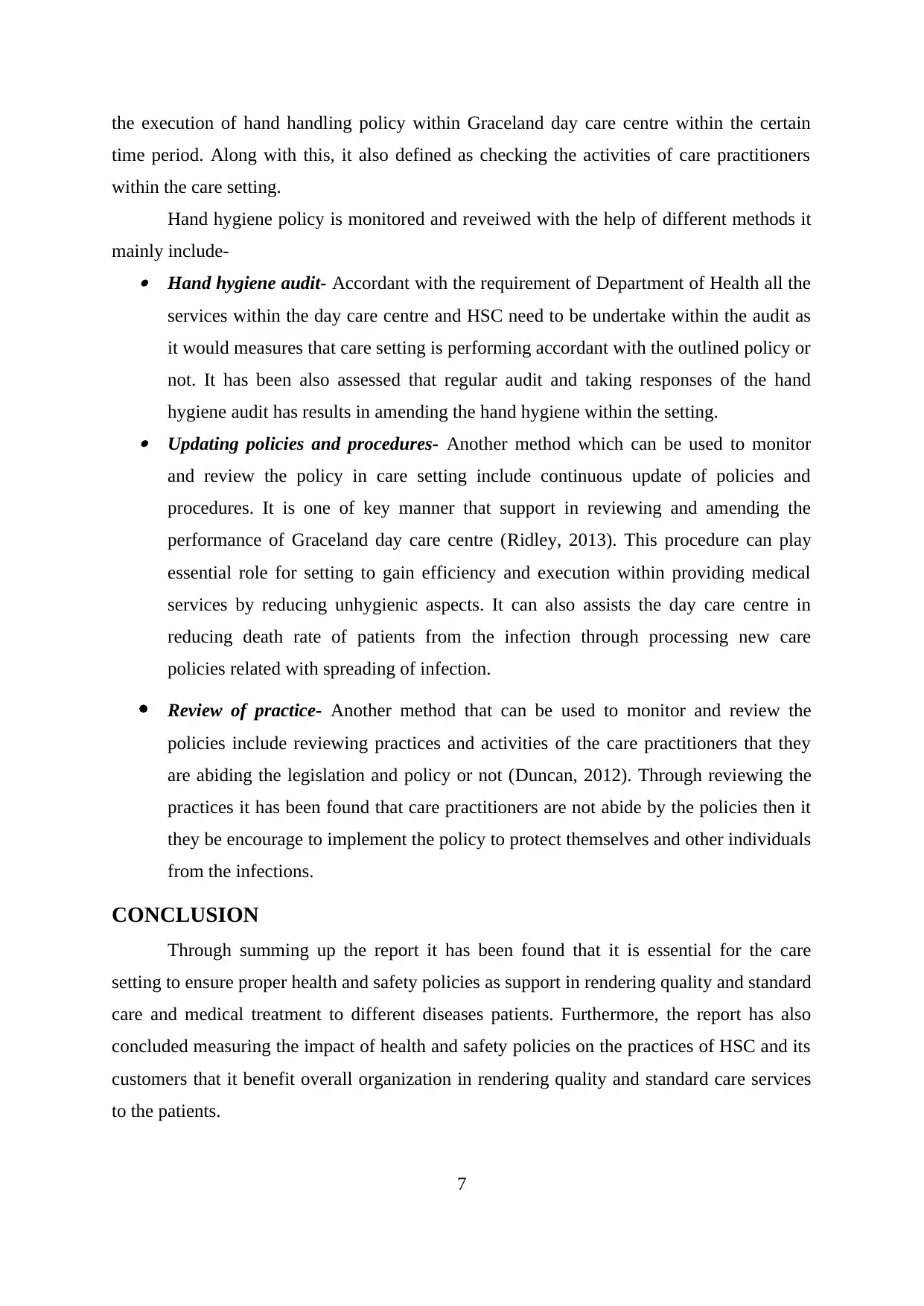
the execution of hand handling policy within Graceland day care centre within the certain
time period. Along with this, it also defined as checking the activities of care practitioners
within the care setting.
Hand hygiene policy is monitored and reveiwed with the help of different methods it
mainly include- Hand hygiene audit- Accordant with the requirement of Department of Health all the
services within the day care centre and HSC need to be undertake within the audit as
it would measures that care setting is performing accordant with the outlined policy or
not. It has been also assessed that regular audit and taking responses of the hand
hygiene audit has results in amending the hand hygiene within the setting. Updating policies and procedures- Another method which can be used to monitor
and review the policy in care setting include continuous update of policies and
procedures. It is one of key manner that support in reviewing and amending the
performance of Graceland day care centre (Ridley, 2013). This procedure can play
essential role for setting to gain efficiency and execution within providing medical
services by reducing unhygienic aspects. It can also assists the day care centre in
reducing death rate of patients from the infection through processing new care
policies related with spreading of infection.
Review of practice- Another method that can be used to monitor and review the
policies include reviewing practices and activities of the care practitioners that they
are abiding the legislation and policy or not (Duncan, 2012). Through reviewing the
practices it has been found that care practitioners are not abide by the policies then it
they be encourage to implement the policy to protect themselves and other individuals
from the infections.
CONCLUSION
Through summing up the report it has been found that it is essential for the care
setting to ensure proper health and safety policies as support in rendering quality and standard
care and medical treatment to different diseases patients. Furthermore, the report has also
concluded measuring the impact of health and safety policies on the practices of HSC and its
customers that it benefit overall organization in rendering quality and standard care services
to the patients.
7
time period. Along with this, it also defined as checking the activities of care practitioners
within the care setting.
Hand hygiene policy is monitored and reveiwed with the help of different methods it
mainly include- Hand hygiene audit- Accordant with the requirement of Department of Health all the
services within the day care centre and HSC need to be undertake within the audit as
it would measures that care setting is performing accordant with the outlined policy or
not. It has been also assessed that regular audit and taking responses of the hand
hygiene audit has results in amending the hand hygiene within the setting. Updating policies and procedures- Another method which can be used to monitor
and review the policy in care setting include continuous update of policies and
procedures. It is one of key manner that support in reviewing and amending the
performance of Graceland day care centre (Ridley, 2013). This procedure can play
essential role for setting to gain efficiency and execution within providing medical
services by reducing unhygienic aspects. It can also assists the day care centre in
reducing death rate of patients from the infection through processing new care
policies related with spreading of infection.
Review of practice- Another method that can be used to monitor and review the
policies include reviewing practices and activities of the care practitioners that they
are abiding the legislation and policy or not (Duncan, 2012). Through reviewing the
practices it has been found that care practitioners are not abide by the policies then it
they be encourage to implement the policy to protect themselves and other individuals
from the infections.
CONCLUSION
Through summing up the report it has been found that it is essential for the care
setting to ensure proper health and safety policies as support in rendering quality and standard
care and medical treatment to different diseases patients. Furthermore, the report has also
concluded measuring the impact of health and safety policies on the practices of HSC and its
customers that it benefit overall organization in rendering quality and standard care services
to the patients.
7
Paraphrase This Document
Need a fresh take? Get an instant paraphrase of this document with our AI Paraphraser
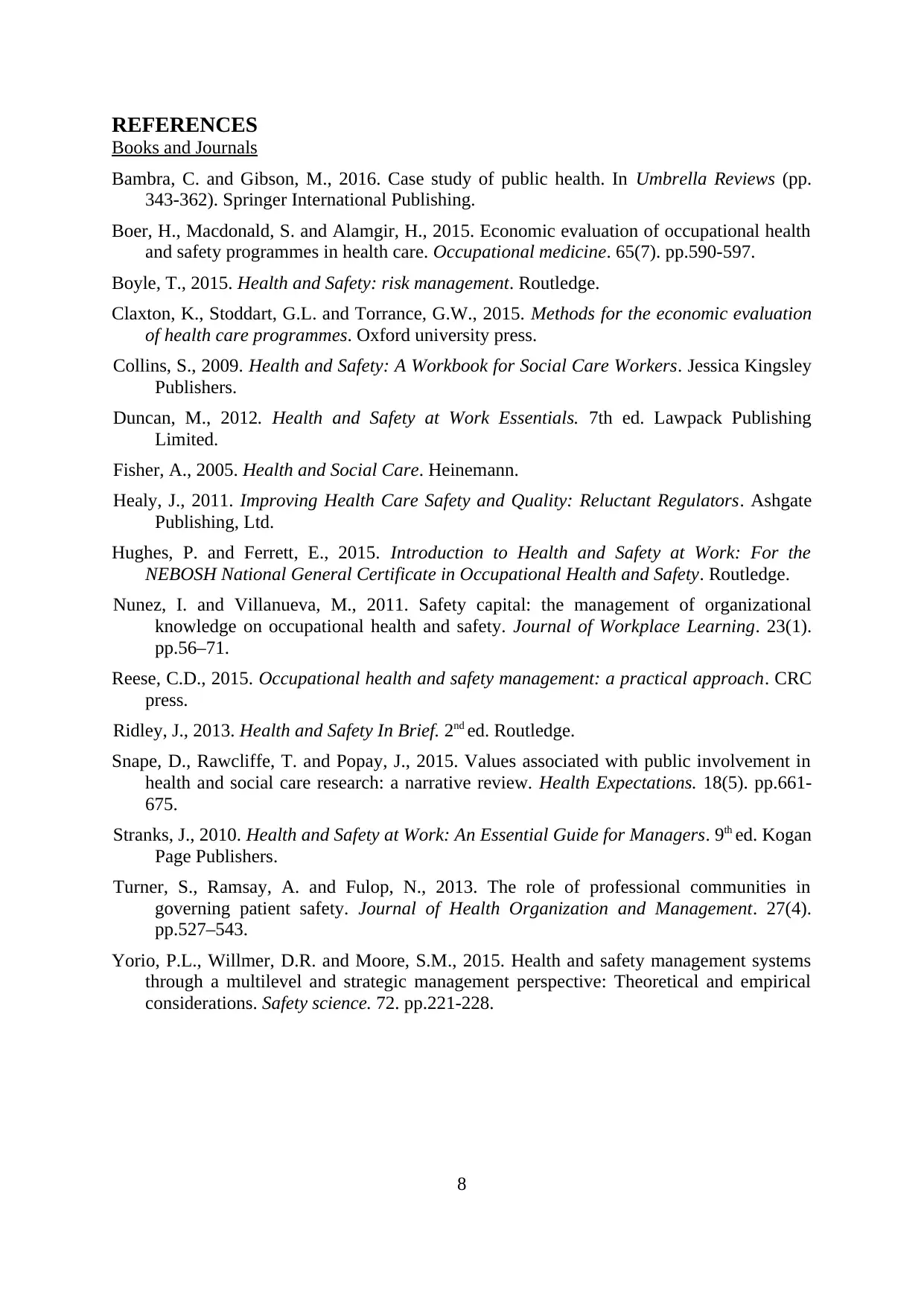
REFERENCES
Books and Journals
Bambra, C. and Gibson, M., 2016. Case study of public health. In Umbrella Reviews (pp.
343-362). Springer International Publishing.
Boer, H., Macdonald, S. and Alamgir, H., 2015. Economic evaluation of occupational health
and safety programmes in health care. Occupational medicine. 65(7). pp.590-597.
Boyle, T., 2015. Health and Safety: risk management. Routledge.
Claxton, K., Stoddart, G.L. and Torrance, G.W., 2015. Methods for the economic evaluation
of health care programmes. Oxford university press.
Collins, S., 2009. Health and Safety: A Workbook for Social Care Workers. Jessica Kingsley
Publishers.
Duncan, M., 2012. Health and Safety at Work Essentials. 7th ed. Lawpack Publishing
Limited.
Fisher, A., 2005. Health and Social Care. Heinemann.
Healy, J., 2011. Improving Health Care Safety and Quality: Reluctant Regulators. Ashgate
Publishing, Ltd.
Hughes, P. and Ferrett, E., 2015. Introduction to Health and Safety at Work: For the
NEBOSH National General Certificate in Occupational Health and Safety. Routledge.
Nunez, I. and Villanueva, M., 2011. Safety capital: the management of organizational
knowledge on occupational health and safety. Journal of Workplace Learning. 23(1).
pp.56–71.
Reese, C.D., 2015. Occupational health and safety management: a practical approach. CRC
press.
Ridley, J., 2013. Health and Safety In Brief. 2nd ed. Routledge.
Snape, D., Rawcliffe, T. and Popay, J., 2015. Values associated with public involvement in
health and social care research: a narrative review. Health Expectations. 18(5). pp.661-
675.
Stranks, J., 2010. Health and Safety at Work: An Essential Guide for Managers. 9th ed. Kogan
Page Publishers.
Turner, S., Ramsay, A. and Fulop, N., 2013. The role of professional communities in
governing patient safety. Journal of Health Organization and Management. 27(4).
pp.527–543.
Yorio, P.L., Willmer, D.R. and Moore, S.M., 2015. Health and safety management systems
through a multilevel and strategic management perspective: Theoretical and empirical
considerations. Safety science. 72. pp.221-228.
8
Books and Journals
Bambra, C. and Gibson, M., 2016. Case study of public health. In Umbrella Reviews (pp.
343-362). Springer International Publishing.
Boer, H., Macdonald, S. and Alamgir, H., 2015. Economic evaluation of occupational health
and safety programmes in health care. Occupational medicine. 65(7). pp.590-597.
Boyle, T., 2015. Health and Safety: risk management. Routledge.
Claxton, K., Stoddart, G.L. and Torrance, G.W., 2015. Methods for the economic evaluation
of health care programmes. Oxford university press.
Collins, S., 2009. Health and Safety: A Workbook for Social Care Workers. Jessica Kingsley
Publishers.
Duncan, M., 2012. Health and Safety at Work Essentials. 7th ed. Lawpack Publishing
Limited.
Fisher, A., 2005. Health and Social Care. Heinemann.
Healy, J., 2011. Improving Health Care Safety and Quality: Reluctant Regulators. Ashgate
Publishing, Ltd.
Hughes, P. and Ferrett, E., 2015. Introduction to Health and Safety at Work: For the
NEBOSH National General Certificate in Occupational Health and Safety. Routledge.
Nunez, I. and Villanueva, M., 2011. Safety capital: the management of organizational
knowledge on occupational health and safety. Journal of Workplace Learning. 23(1).
pp.56–71.
Reese, C.D., 2015. Occupational health and safety management: a practical approach. CRC
press.
Ridley, J., 2013. Health and Safety In Brief. 2nd ed. Routledge.
Snape, D., Rawcliffe, T. and Popay, J., 2015. Values associated with public involvement in
health and social care research: a narrative review. Health Expectations. 18(5). pp.661-
675.
Stranks, J., 2010. Health and Safety at Work: An Essential Guide for Managers. 9th ed. Kogan
Page Publishers.
Turner, S., Ramsay, A. and Fulop, N., 2013. The role of professional communities in
governing patient safety. Journal of Health Organization and Management. 27(4).
pp.527–543.
Yorio, P.L., Willmer, D.R. and Moore, S.M., 2015. Health and safety management systems
through a multilevel and strategic management perspective: Theoretical and empirical
considerations. Safety science. 72. pp.221-228.
8
1 out of 8
Related Documents
Your All-in-One AI-Powered Toolkit for Academic Success.
+13062052269
info@desklib.com
Available 24*7 on WhatsApp / Email
![[object Object]](/_next/static/media/star-bottom.7253800d.svg)
Unlock your academic potential
Copyright © 2020–2025 A2Z Services. All Rights Reserved. Developed and managed by ZUCOL.





